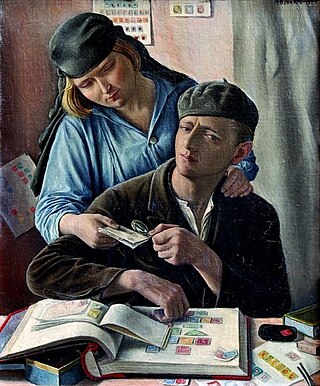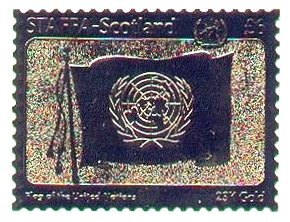
Stamp collecting is the collecting of postage stamps and related objects. It is an area of philately, which is the study of stamps. It has been one of the world's most popular hobbies since the late nineteenth century with the rapid growth of the postal service, as a stream of new stamps was produced by countries that sought to advertise their distinctiveness through their stamps.

Philatelic literature is written material relating to philately, primarily information about postage stamps and postal history.

The Inverted Jenny is a 24 cent United States postage stamp first issued on May 10, 1918, in which the image of the Curtiss JN-4 airplane in the center of the design is printed upside-down; it is one of the most famous errors in American philately. Only one pane of 100 of the invert stamps was ever found, making this error one of the most prized in philately.

Philatelic investment is investment in collectible postage stamps for the purpose of realizing a profit. Philatelic investment was popular during the 1970s but then fell out of favour following a speculative bubble and prices of rare stamps took many years to recover.
This is a list of philatelic topics.

A stamp catalog is a catalog of postage stamp types with descriptions and prices.

A cancelled to order postage stamp, philatelic symbol , is a stamp the issuing postal service has cancelled, but has not traveled through the post, but instead gets handed back to a stamp collector or dealer. They can come from withdrawn stocks of stamps cancelled in sheets and sold as remainders or from new sheets for sale at reduced rates to the stamp trade. Postal services of various countries do this in response to collector demand, or to preclude stamps issued for the collector market being used on mail. Some of the history of CTOs is from stamps being given to collectors on an approval basis, in person or through mailings; the first CTOs began in the late 19th century.

The Stanley Gibbons Group plc is a company quoted on the London Stock Exchange specialising in the retailing of collectable postage stamps and similar products. The group is incorporated in London. The company is a major stamp dealer and philatelic publisher. The company's philatelic subsidiary, Stanley Gibbons Limited, had a royal warrant of appointment from Queen Elizabeth II.

The 2¢ Large Queen on laid paper is the rarest postage stamp of Canada. Printed in 1868, it was not discovered until 1925, and so far only three have been found, all used. Many more could exist as at least one sheet must have been printed, and possibly many sheets; however, they may all have been destroyed, or lie unrecognised in stamp collections or on cover.

The British Guiana 1c magenta is regarded by many philatelists as the world's most famous rare stamp. It was issued in limited numbers in British Guiana in 1856, and only one specimen is now known to exist. It is the only major postage stamp ever issued in the United Kingdom or British Commonwealth that is not represented in Britain's Royal Philatelic Collection.

The Mauritius "Post Office" stamps were issued by the British Colony Mauritius in September 1847, in two denominations: an orange-red one penny (1d) and a deep blue two pence (2d). Their name comes from the wording on the stamps reading "Post Office", which was soon changed in the next issue to "Post Paid". They are among the rarest postage stamps in the world.

The Rare 2d Coil was an experimental vertical coil stamp, denominated 2d, issued by the Irish Post Office in 1935 and is one of the scarcest, and most valuable, Irish stamps. It is often referred to by stamp collectors simply as "Scott 68b" or "SG 74b", being the Scott and Stanley Gibbons stamp catalogue numbers respectively.
Littleton Coin Company is an employee-owned privately held major American mail order and retail company focused on numismatic (currency) collectibles and based in Littleton, New Hampshire. The company focuses largely on U.S. coins and world coins, as well as a variety of paper money and ancient coins. Largely focused on direct mail, Littleton publishes catalogs several times yearly and has a "coins-on-approval" program.

A philatelic auction, or stamp auction, is a sale of stamps, covers and other philatelic material usually run by stamp dealers or specialist collectibles auctioneers, such as David Feldman, Christie's and Sotheby's, where prospective purchasers place bids in an attempt to obtain the desired items.
Charles James Phillips of London, England, and New York City, was a philatelist highly regarded in both England where he started his philatelic career and in the United States, where he emigrated to in 1922.

Clive Harold Feigenbaum (1939–2007) was a colourful and controversial British businessman who was involved in a lifelong series of scandals in the world of philately. Particularly notable was the sale of "gold" stamps from Staffa and his role in the collapse of attempts to list Stanley Gibbons on the Unlisted Securities Market in 1984.
Asian philately, or Far-Eastern philately, is a specialized area of philately which focuses on the stamps of China, Japan, Hong Kong and neighboring countries. Stamp collectors and stamp dealers often specialize in a particular aspect of Asian philately, and many stamp auctions are devoted to this area of interest. Hong Kong is a major center for Asian philately with Chinese collectors and investors some of the biggest buyers.
The Golden Monkey Stamp or Gēngshēn Monkey is a postage stamp issued in China in 1980 of which 5 million copies were printed. Although not rare, the stamp has come to symbolise the strong market for collectable postage stamps in Asia. Demand for the stamp has made it one of the most sought after contemporary Chinese stamps.

The Crawford Library is a library of early books about philately formed between 1898 and 1913 by James Lindsay, 26th Earl of Crawford. By the time of his death in 1913, Crawford was thought to have amassed the greatest philatelic library of his time. Today, the library is part of the British Library Philatelic Collections.

Ramón Antonio Plácido de Torres, known as Plácido Ramón de Torres, was a Spanish stamp illustrator, dealer, and forger.
















